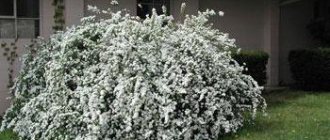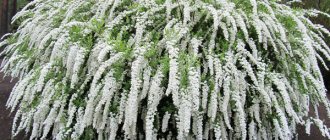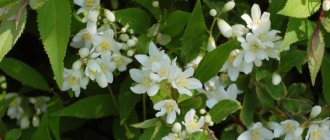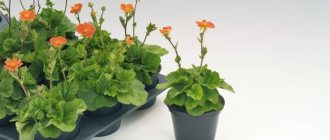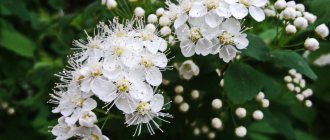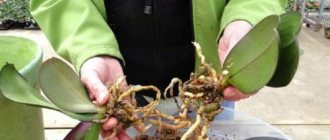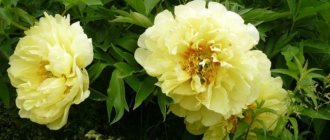27938
To obtain a dense hedge from one flowering shrub, it is enough to collect, root and plant several of its cuttings. Gardeners recommend paying attention to spirea: propagation by cuttings in spring, summer and autumn is equally successful for this plant. In order for the bush to be strong and have a beautiful shape, the simplest rules of care should not be neglected.
Spiraea grown by cuttings
Transplantation into open ground and further care
The timing of planting young seedlings in open ground depends on the characteristics of the region.
In the middle zone, work is carried out in early spring or autumn before leaf fall. In colder regions, spring planting is preferred. Spiraea can be planted either in a well-lit or slightly shaded place. You should not place the shrub in the shade, as its inflorescences will begin to shrink due to a lack of light. It is worth considering that most varieties of tree peonies, clematis, and large-leaved hydrangeas will not take root in a shady place. The workpieces rooted in September-October are moved to the garden bed next spring. Cuttings that took root in spring and summer can wait until fall or next spring.
In order for young spirea to grow and bloom, the soil on the site must be slightly acidic or neutral, loose, and permeable. If the soil is heavy, then the size of the planting pit is increased several times, placing a drainage layer on the bottom
When organizing planting and caring for mock orange, this rule is also taken into account.
Even a beginner can plant young spirea in the garden, following a few simple tips:
- Planting work begins with the preparation of a nutrient substrate for filling the hole from 2 parts of garden soil, 1 part of sand and 1 part of peat.
- Dig planting holes 1.5-3 times wider and deeper than the size of the root system of the seedling. Pebbles, broken bricks and coarse sand are placed on the bottom.
- Carefully remove the seedling from the pot, place it in the hole and straighten the roots.
- Cover the bush with a substrate prepared in advance so that the root collar remains at ground level.
- Water the tree trunk abundantly and mulch it.
If you decide to plant several spireas, then leave 50-70 cm between the bushes. When creating a hedge, it is enough to provide a distance of 40-50 cm.
Video with recommendations for growing garden spirea from cuttings.
In the first years of growth, the shrub requires more painstaking care:
- The primary condition for rapid acclimatization of a spirea bush is moderate humidity. Since the root system lies close to the surface, it can dry out on hot days. Watering should be moderate; on rainy days the bush can do without additional moisture.
- To additionally protect the roots and maintain the necessary moisture, the tree trunk circle is periodically mulched with peat and tree bark.
- Growing decorative spirea is impossible without applying fertilizers. In spring, the bush needs a liquid mineral complex, in summer – organic matter and superphosphate. All fertilizers are applied after watering.
- For the winter, young shrubs are protected from the cold. The branches are tied together, bent to the ground, sprinkled with dry leaves in a 10 cm layer, and spruce branches are placed on top.
- Pruning is a mandatory procedure to maintain the beautiful appearance of spirea. The first haircut is carried out after wintering. All frozen and dry branches are cut off completely.
Cuttings are the most popular method of propagating perennials. Both green and lignified shoots take root well, germinate quickly and do not require special maintenance conditions, which means that even a novice gardener can grow wildly flowering spirea from cuttings.
Planting ready-made cuttings
Transplantation of finished cuttings, prepared and rooted in summer, is carried out in mid-autumn. To do this, choose a flat, well-lit area of land, protected from drafts, with loose fertile soil.
Prepare planting holes, the width and depth of which are 3 and 1.5 times, respectively, the size of the root system of the seedling.
Reference. The distance between planting holes is 40–70 cm.
The plant is placed in the hole, the roots are carefully straightened and covered with a mixture of garden soil, peat and sand (1:1:1). The seedlings are watered and the soil around them is mulched.
Useful tips
To propagate spirea from cuttings, you do not need to be a professional gardener. This procedure is quite simple, even a beginner can cope with it. To successfully grow shrubs, you can use the following useful recommendations:
- to protect cut shoots from diseases and parasites, they can be treated with a solution of potassium permanganate;
- the best “neighbors” in the garden plot are coniferous crops;
- when planting in a permanent place, it is recommended to place drainage made of brick chips or a mixture of sand and pebbles in the hole;
- for one year after planting spirea in a garden plot, the plant needs careful care; Watering should be carried out constantly so that the roots cannot dry out;
- during active growth, bushes transplanted into open ground need to be fed; Mineral compounds and organic fertilizers can be used as fertilizing.
You can learn more about propagating spirea by cuttings from the video below.
Is it possible to propagate spirea from cuttings in summer?
Vegetative propagation of spirea is the simplest and therefore most common method. Cuttings are carried out with equal success throughout the growing season: from spring to autumn.
Some gardeners perform the procedure in the summer, starting in July, citing the following benefits:
- the ability to immediately prepare planting material, since by this time the active growth of greenery on plants blooming in spring ends, and the cuttings remain green and semi-lignified;
- rooting before the onset of cold weather;
- plant survival rate is 70%.
Summer cuttings can be associated with certain difficulties caused by weather conditions. So, you often have to wait so that it is not too hot and dry. Otherwise, there is a risk that the cutting will not take root.
Vegetative propagation of spirea
How to propagate spirea from cuttings
Most spireas are propagated by cuttings, and both green, summer and semi-lignified autumn cuttings are used for rooting. Cuttings are the most productive method: cuttings of spirea such as Vangutta, willow-leaved, plum-leaved, dwarf, Nippon, white-flowered, medium, low and dense-flowered are successfully rooted in 70% of cases. Cuttings of birch-leaved and oak-leaved spirea have one hundred percent success, and only one-third of the cuttings of sharp-toothed spirea take root.
Experienced gardeners prefer to propagate spirea by cuttings in the fall, in September or October, although spring-flowering species can be propagated by cuttings from the first half of June, and late-flowering species from July. Strong shoots are separated from the bush and divided into parts with 4-5 leaves on each. The lower leaf is removed from each cutting, and the upper ones are cut in half. Semi-lignified cuttings are soaked for 2-3 hours in water, and immediately before planting, the lower part of each segment is powdered with a root former.
The cuttings are planted at an angle of 45˚ in a substrate consisting of equal parts of coarse river sand and high-moor peat, and covered with a transparent dome. Caring for cuttings consists of regularly ventilating and moistening the substrate, as well as daily spraying of cuttings from a fine sprayer with non-cold water. Summer cuttings are planted in a permanent place in the spring, and winter cuttings - in the fall. During transplantation, the roots are picked (shortened).
Reproduction of spirea by layering
This method of propagation also gives reliable results. In early spring, a shoot of a spirea bush is placed in a dug ditch, pinned in it and covered with earth. The tip of the shoot should remain above the ground. If you need to get several seedlings from cuttings, you need to pinch the top. During the season, the cuttings are watered together with the mother plant, covering the shoots growing from it with humus, and in the fall it is dug up, divided into parts and planted in pre-prepared holes.
Reproduction of spirea by dividing the bush
Divide those spirea bushes that are 3-4 years old, since in older plants the root system is bound by a too dense earthen lump, which is difficult to destroy without damaging the roots. You can divide the bush at any time except winter, but it is better to do it in late summer or early autumn. It is advisable to choose the time so that after the completion of the procedure the weather will be cloudy for several days.
White spirea on the site
The spirea bush is dug up, trying to damage as few roots as possible. Although most likely the peripheral roots will have to be cut off. The root system is thoroughly washed, and to remove all the soil, the roots are placed in a container with water for an hour. Straighten the root shoots, divide the bush with a sterile pruner into approximately equal parts, each of which should receive several shoots and a ball of roots. The roots need to be slightly shortened, and the cuts should be treated with crushed coal. The delenki are planted in pre-prepared holes and watered abundantly several times. If it is hot, you will have to water them daily at first.
Growing spirea by layering
Obtaining layering is suitable for those who need several shoots from one bush at once. This method of growing is best done in early spring, selecting shoots from below, which need to be slightly broken, secured to the ground and sprinkled with soil. The inflorescences of the main bush need to be cut off so that it spends energy on the appearance of roots in the shoots. The soil underneath should be slightly moist at all times. At the end of the season, the cuttings will have their own root system, but they can only be replanted next spring.
Spiraea propagation methods in spring and autumn
Cuttings
For spirea, cuttings are considered the most favorable propagation. Since this is a vegetative method of propagation, all the characteristics of the variety are preserved during cultivation.
Cuttings in stages:
Only young shoots, preferably annual or younger, that grow strictly straight, are suitable for cuttings. The sprout is cut off, which should have 4-5 nodes with double leaves, the lower pair of leaves is removed. It is recommended to make cuts at an angle; the length of the cut cuttings is 10-15 cm.
For better propagation, after cutting, the cuttings are placed in a solution of Epin or Zircon (another biostimulant is also suitable) for 9-11 hours, the solution is made up in the proportion of 1 ml of biostimulant per 2 liters of water. It would not be superfluous to use root-forming powder stimulants - Ukorenit, Kornevin. They sprinkle on the ends of the cuttings.
The next step is to place the cuttings in damp sand. They should be placed at an angle and buried by 2-3cm, then sprayed and covered with a jar or film. It is better to place the container with sand in a place protected from direct sunlight.
The container with the cuttings is taken outside and placed in a shady area; cuttings require regular spraying and watering. By winter they are covered with leaves, and in the spring they are planted in open ground.
Video about propagation of Spiraea by cuttings
https://youtube.com/watch?v=JIqcB-PvkWw
By layering
An easier way. Suitable if you need to get a small amount of sprouts. In spring, young branches of spirea (preferably the lower shoots) fall to the ground and are pinched with a V-shaped rod or wire. Sprinkle soil on top.
Next spring the root system of the shoots will be fully formed. You can separate the sprouts from the main spirea bush and replant them for independent growth.
Seeds
A convenient way to get a lot of spirea sprouts at once. However, there are also subtleties here. Propagation by seeds is not suitable for all types of this shrub. If you are not 100% sure or it is impossible to determine the type of spirea from the seeds, you can conduct a test sowing of the shrub. In the fall, I plant several seeds in a pot (the quantity is optional), water it well and sprinkle it with soil in an open area; for the winter, the sprouts are insulated accordingly. In the spring, it will be possible to determine the type of spirea from the seedlings.
Only Japanese spirea, Nippon spirea and oak-leaved spirea can be propagated by seeds. Seeds of other species and varieties do not germinate well, and in the future their hybrids may change.
Several simple stages of seed propagation
In the summer, seed pods are cut from the bushes and placed in a dark, dry place for 2 weeks to ripen.
It is important to have time to cut the boxes before they open (in July - August)
Next, the seeds are removed, and they can be planted in a box from mid-October and throughout November, or in the spring in April. The soil should also be prepared in a ratio of 1:4 - vermiculite and non-acidic peat, respectively. The box on the site is sprinkled with soil; if sowing is done in the spring, the soil in the box should be thoroughly sprayed and covered with film until the first seeds sprout; Regularly monitor soil moisture.
After several months, the sprouts should be pruned. By this time they usually reach a height of 2-3 cm; sit at a distance of 8-10 cm from each other.
The box is again sprinkled with soil; it is advisable to place it in a shady place for the summer and water it regularly.
In the fall, the sprouts can be transplanted into open ground into beds, and only a year later to the chosen permanent place for them. Spiraea sprouts take root and adapt well, but they will begin to bloom no earlier than three years later.
When choosing spirea as a decoration for a site, it is impossible to regret your choice in the future. This shrub pleases with long flowering and unpretentiousness. It can be propagated and replanted at almost any convenient time, and with the help of chic forms it can be used to create unique landscapes and compositions. Spiraea can perform decorative functions in the garden, delight the eye with single flowering shrubs, or serve as a hedge.
I have spirea grefsheim in my summer cottage. This is an unusually beautiful plant, which, as it turns out, does not require much care. I fertilize it once a season with universal fertilizer, and it makes me happy with its appearance. She has already provided for all her neighbors. I propagate by layering (I simply pin a branch to the ground and periodically moisten the soil). I highly recommend it to anyone who doesn’t have spirea.
Deadlines
The choice of timing for propagation in most cases turns out to be related to the gardener’s desire to use different types and methods of plant propagation. In the case of spirea (a rather unpretentious shrub), seasonal restrictions are not so important. If certain rules are followed, it will be possible to complete all the necessary tasks even in the summer.
in spring
The choice of timing for spring breeding may vary. Most often, planting times occur during the following periods.
- The period before the buds swell. It arrives around mid-March. If the deadline is missed and the leaves begin to grow, you should not touch the plant.
- At the end of spring, before flowering. At this time, the most active period of the growing season is replaced by other processes and the changes are not so dangerous.
In summer
In the summer, propagation of shrubs by layering, division, and cuttings is recommended only if the weather is cloudy, without drought, or scorching sun. Loss of moisture is always detrimental to young seedlings; they may not take root or wither.
In the summer months, the optimal period for reproduction is the end of flowering. It usually falls in mid-June or the first week of July.
in autumn
The autumn months mean the possibility of planting spirea only before the onset of the first frost. It will be better if all the necessary manipulations can be completed in mid-September. It is believed that autumn propagation is the most productive, since it reduces the plant's care needs to a minimum. In most cases, it is enough to simply mulch and insulate the seedlings well. At the same time, the survival rate of plants is as high as possible.
Reproduction of spirea
Spiraea propagates by seeds and vegetatively: by dividing the bush, layering and cuttings.
Growing spirea from seeds
Not all types and varieties of spirea are propagated by seeds, but only those that form full-fledged seed material, for example, Japanese, Nippon and oak-leaved spirea. Browned but not yet opened seed pods are cut off, ripened indoors in a cardboard box, and after two weeks the ripened seeds are poured out of them. Sowing is done in the spring in a shallow box filled with a mixture of 4 parts peat and one part vermiculite. The seeds spread on the surface are not covered, but sprayed with a spray bottle, after which they are covered with film or glass and placed under diffused light. From the moment the sprouts begin to appear, the covering is removed, and the seedlings, along with the box, are taken out into the garden. As soon as the seedlings reach a height of 2 cm, they are planted in separate containers, shortening the roots that are too long by a third, and in the second half of August the seedlings are placed in the school bed. Young plants are planted in a permanent place next spring.
Reproduction of spirea by cuttings
This is the most effective way to propagate spirea with a high survival rate of 70%. Spiraea is cut from both spring and early summer, most often using plant residues from pruning. The length of cuttings with at least four internodes and an oblique lower cut should be 10-15 cm. The lower pair of leaves is removed and the rest are shortened by half. Before planting, the cuttings are kept for half a day in a solution of a growth stimulant - Epin or Zircon, after which the lower cut is powdered with Kornevin. The cuttings are planted in a container with damp sand, after which they are sprayed and covered with a transparent cap. As soon as new leaves begin to appear on the cuttings, the film is removed from them, the container is taken out into the fresh air and placed in the shade. Caring for cuttings consists of regular spraying and watering the soil. With the onset of cold weather, the container is placed in a frost-free cellar or dug in in the garden, covered with burlap or dry leaves on top, and with the arrival of warmth, the cuttings are planted in a permanent place.
Reproduction of spirea by layering
It is easy to propagate spirea by layering. To do this, you need to bend a low-growing branch or young shoot to the ground, fix it in this position and sprinkle it with earth. Caring for the cuttings involves regular watering and fertilizing. Keep in mind: if you completely cover the cuttings with soil, it will produce numerous shoots, and if you leave the tip of the shoot above the surface, then in the spring it will form a developed single plant.
Reproduction of spirea by dividing the bush
It makes sense to propagate spirea by dividing the rhizome only when replanting the bush. A plant that has reached three to four years of age can be divided throughout the season. Please note that the survival rate of the cuttings improves if the weather is cool and cloudy for 7-10 days after transplantation.
The bush is dug up, cutting off the roots that extend too far to the sides. The root system is placed in a container with water for an hour and a half to remove the soil. Using a sharp sterile knife or pruning shears, divide the bush into several parts so that each of them remains with a root lobe and 2-3 developed shoots. The sections are sprinkled with crushed coal, after which the sections are planted in pre-prepared planting holes. After planting, the surface is compacted, watered and mulched with humus or dry peat.
Advice from experienced gardeners
Growing spirea from cuttings does not cause any particular difficulties. However, there are some points, knowledge of which greatly facilitates the propagation and cultivation of shrubs:
- Summer cuttings with semi-lignified shoots are carried out in the second half of summer.
- Straight shoots from 10 to 15 cm long, which bear at least 4 buds, are suitable for cuttings.
- When planting a cutting, be sure to take into account the angle of inclination of 45°. This way rooting goes better.
- Dipping the lower cut of the shoot in dry “Kornevin” or “Heteroauxin” promotes rapid establishment.
- Rooting takes at least a month, during which the cutting is provided with a warm, moist environment, covered with film or a cut plastic bottle.
- It is better to plant spirea in a sunny area. Partial shade has a bad effect on the splendor of flowering.
- Maintaining the required level of humidity in containers with cuttings is facilitated by regular spraying of the plants and the soil underneath them.
This is interesting:
How to care for a home rose in a pot - a guide for beginner gardeners
A guide to cutting roses in the fall at home for beginning gardeners
Simple ways to save rose cuttings until spring and plant them correctly
How to propagate a climbing rose by cuttings in the summer step by step
Why do you need to prune petunia in the middle of summer and how to do it correctly
Propagation of spirea in summer using cuttings
Knowing how spirea reproduces in summer, it is better to choose cuttings for cultivation. Thus, the bush is propagated using green or woody cuttings, depending on the time of year. It is worth taking annual or last year's sprouts, the bark of which remains light during growth. Cuttings of such spirea are carried out in the summer, but the sprouts themselves are prepared in cloudy weather.
Important! Materials for planting are cut only from healthy bushes; if there are pests, the main plant will need to be treated
Cuttings of spirea
In order to root the cuttings well, the spirea is pruned; green shoots are selected for this procedure. Their tops need to be cut off to avoid rotting; in this case, planting will be possible even for novice gardeners. The prepared cuttings should not have leaves at the bottom; it is enough to leave only the top four. The sheet plate itself is made shorter by a third.
Cuttings from the bottom are moistened in a solution of potassium permanganate, then the shoots are planted in a substrate with the addition of a nutrient concentrate. Each branch should be at a depth of at least 1.5-2 cm, with a gap of 3 cm left between them. For rooting purposes, a place in the shade that is well ventilated is suitable. The shoots are additionally covered with a bag or glass to create a greenhouse effect. They are planted in a permanent place after complete rooting.
Reproduction of spirea
Features of cuttings of Japanese spirea in summer
Japanese spirea, or bride, whose full care and reproduction should be carried out according to the rules, has its own differences. You need to plant cuttings at least 7-15 cm long, taking into account the size of the main plant. Their shoots are cut with a razor or a sharp knife just below the node, and the leaves on the underside are removed. Then the ends of the cuttings are dipped into a solution with a phytohormone. When they have stood there for several hours, they can be planted in pre-prepared holes in the soil.
How to root white spirea from a twig
You can easily root a white spirea or Vangutta bush from a twig at home
It is important to plant the sprouts in the substrate so that they quickly form a root system. To prepare it, sand and high-moor peat are mixed.
The cuttings are kept in solution in advance, then dipped in a growth stimulator, and then transplanted into the soil. For the purpose of disinfection, plantings can be sprayed with garlic solution, adding 1 teaspoon of the resulting pulp to 1 liter of water.
How does spirea reproduce?
There are several ways to propagate this spectacular shrub. The most reliable ones that guarantee results are:
- cuttings
- division of the root system,
- rooting of cuttings.
Spiraea White Bride
You can try growing spirea from seeds. However, you should know that, firstly, spirea seeds quickly lose their viability, and secondly, it is impossible to grow hybrid plant varieties from seeds.
Propagated by seed:
- Japanese spirea;
- Spiraea Nipponica;
- Spiraea Wangutta;
- Spiraea oakleaf.
Seeds of these varieties retain up to 80-90% germination.
Rooting
To stimulate root growth after cutting, it is recommended to place the branches in a special composition for some time. In the store for these purposes you can purchase such products as “Kornevin”, “Heteroauxin” and “Vympel”. After processing the branches, they need to be planted in small containers. Let's look at the rooting process step by step.
To root shoots at home, you first need to prepare the substrate. The easiest way is to use wet sand. You can also mix sand with peat or use any other loose soil. It is recommended to treat the substrate with a fungicide to prevent root rotting. As for the containers in which the branches will be planted, any containers with holes in the bottom will do. Correctly plant cuttings to a depth of 3 cm at an angle of about 45 degrees.
It is necessary to maintain the angle of inclination so that the growth of the upper parts of the branches slows down, and root formation, on the contrary, intensifies. It is important that the soil is moist during planting. After the branches are immersed in the substrate, they also need to be sprinkled with water
It is advisable to cover the top of the cuttings with film or a cap from a plastic bottle. This manipulation is necessary to create conditions of high humidity and maintain temperature. Periodically, the seedlings are taken out of the shelter and moistened with a spray bottle. During cultivation, it is important to prevent the soil from drying out, but at the same time not to over-moisten the spirea. Containers with cuttings should be placed on the windowsill, where the sunlight will not be too bright. An alternative way to keep seedlings for rooting is to bury containers in the garden. Dry leaves or peat should be placed on top of the soil so that the root system does not freeze. In winter, containers with seedlings are put into the basement or transferred to another dark, cool place.
You can grow shoots not only in pots. If desired, a greenhouse can be built on the site for the spirea.
- First, the bed is dug up and organic fertilizers are added. It is recommended to add peat mixture and river sand to the soil. Then it is recommended to moisten the soil well.
- The branches are planted at a distance of at least 10 cm from each other. Next, you need to install the greenhouse frame and stretch the film on top. The polyethylene must be firmly fixed, pressed to the ground along the perimeter of the greenhouse with bricks or other heavy objects.
- It is recommended to open and ventilate the mini-greenhouse periodically. And also do not forget about regular watering of seedlings. For the winter, the film is removed and the cuttings are sprinkled with a peat mixture.
Varieties of shrubs of the genus Spiraea
All plants of the genus Spiraea can be divided into two large groups: spring- and summer-flowering. The former bloom profusely, but do not last long. Shrubs of the second group do not bloom at the same time, but for two months. The flowers have more saturated shades. Low-growing varieties are often used to decorate alpine slides.
Spring-flowering varieties
Spring-flowering varieties begin to bloom in mid-May. Their peculiarity is that they are all white. Shades may vary, but the color is white. Plants begin to bloom in the second year of life and bush heavily. The most popular types of shrubs are:
Spiraea gray. The plant received this name not because of the color of the petals (they are white, like all spring-flowering species), but because of the gray-green color of the leaves. This is the most common type of spirea. Flowering period is from May to mid-June. Inflorescences are located along the entire length of the shoot.
The gray spirea "Grefsheim" receives special attention from gardeners. The plant reaches 1.5-2 m, has a spreading crown and boiling-white flowers up to 1 cm in diameter, collected in umbrella inflorescences.
Gray spirea Grefsheim “gets along” well with Nippon spirea and arguta, broom, viburnum, and conifers
Spiraea Vangutta. This hybrid of Cantonese and three-lobed spirea reaches 2 m. The flowers are small - up to 0.6 cm, collected in hemispherical inflorescences. The leaves, dark green above and dull gray below, turn reddish in autumn. This variety can bloom twice - in early June and in August.
Spiraea arguta. The bushes of the plant reach 1.5-2 m and have a beautiful shape. During flowering (from late May to mid-June), Spiraea arguta looks like a white fragrant waterfall.
Summer-flowering varieties
Their inflorescences appear at the ends of young shoots. At the same time, last year's branches die off. Summer-flowering species are represented by varieties of Japanese spirea, loosestrife, Bloomalda and others. The flowers may be pink or red.
First, let's talk about Japanese spirea. Its bushes reach 1-1.5 m in height. The leaves are green above and dull gray below, oblong, ovate; in autumn they turn yellow or red. The flowers are pink-red, collected in paniculate-corymbose inflorescences. The plant blooms for up to 45 days. The following varieties are common:
- "Shirobana." Distinctive features of the variety are small leaves (2 cm) and white or pink flowers. Blooms in July-August.
- "Goldflame". The leaves of the shrub change color depending on the time of year - from yellow to copper-orange. Blooms with red-pink small flowers.
- "Crispa." Blooms from July until the end of summer. The flowers are small, pale pink, collected in flat umbels.
- "Little Princesses". Low-growing (up to 0.6 m), slowly growing variety. The flowers are large - up to 4 cm in diameter, red-pink, collected in corymbose inflorescences. The plant blooms in mid-summer - June-July.
- "Golden Princesses" This is one of the varieties of "Little Princesses". The variety is distinguished by its higher bush height - up to 1 m, and yellow leaves.
Japanese spirea is one of the most common, but far from the only summer-flowering species. Also deservedly popular are:
- Spiraea Boumalda. This is a hybrid species. Plants reach a height of 0.5-0.8 m, have erect shoots and very beautiful leaves - green in summer, and yellow, red with a purple tint in autumn. The flowers are pink.
- Among the Bumald spireas, the most common variety is “Goldflame”. The shrub reaches a height of 0.8 m. If the plant is planted in the sun, its leaves change color depending on the season - from delicate golden-orange to copper-red. The leaves of bushes planted in the shade do not undergo such changes.
- Spiraea willow leaf. The variety is distinguished by long pointed leaves (up to 10 cm) and white or pink flowers. Inflorescences can reach a length of 20 cm.
- Spiraea Douglas. Flowering period – July-September. The flowers are dark pink. The bushes grow up to 1.5 m tall.
- Spiraea Billarda. This is a hybrid of the willow spirea and Douglas. The bushes are tall - up to 2 m. The flowers are pink, collected in long inflorescences. Blooms from mid-summer until frost.
Even before the final choice of the location for planting the shrub, you should decide on the desired size and type of plant. Varieties vary in size: they can be compact and fit in a small area, or they can grow upwards and to the sides. Therefore, for solitary planting, design of hedges and alpine slides, different types of plants are chosen.
Spiraea “Little Princess” looks great in combination with other varieties of spirea, conifers, and lavender. This type is suitable for decorating flower beds, rock gardens, and areas near ponds
Billard's spirea is frost-resistant and shade-tolerant, but it is better to plant it in well-lit areas
Spiraea Wangutta produces numerous basal shoots and is perfect for single planting
For hedges, you should choose varieties that produce little root shoots and are easy to trim. Alpine slides can be decorated with slow-growing varieties. And for single planting, it is better to choose plants with developed basal shoots that occupy a large area. For rockeries and rocky gardens, dwarf varieties are used. By choosing several varieties that bloom at different times, the gardener can achieve spirea flowering from spring to autumn cold weather.
Recent Entries
Lilac perennials that are beautiful, compact and do not crowd out other plants Why when buying seedlings you should not take the sellers’ word for it and how to determine the age of the plant using 3 signs Tomato seedlings have turned purple or whitish: why the color has changed and how to save the plants
Harvesting cuttings
As noted earlier, it is recommended to harvest branches in cool and cloudy weather. Branches are cut from healthy and strong bushes. If the plant has signs of damage by diseases or parasites, then before taking cuttings the bush must be treated with special means. After spraying, shoots can be cut off no earlier than on the fourth day. If it was not possible to cure the plant the first time, it is recommended to repeat the treatment of the bush. For propagation, you need to cut only straight branches growing upward. Brown shoots should not be older than one year.
If the harvesting of branches occurs in the summer, then those shoots on which flowering has already stopped are cut off. It is desirable that all the leaves on them are intact. Both very young cuttings and annual cuttings are suitable for propagation. The length of the cut branches should be about 11–15 cm. Each cutting should have at least 4 green leaves or buds. It is necessary to cut off the shoot with a sharp knife or blade at an angle of 30 degrees. The top of the branch also needs to be trimmed, but this time exactly at a right angle.
Important! It is recommended to trim the leaves a little: the two lower ones are completely removed, and the upper ones are shortened exactly by half. This procedure will speed up the rooting of cuttings, as it will ensure less moisture loss
Diseases and pests
The garden shrub spirea rarely becomes the target of attacks by insect pests and common garden diseases. However, this still happens from time to time. In this case, the plant becomes seriously ill, and this often ends in the death of the bush.
The shrub may suffer from the following insects:
- aphid;
- spider mite;
- whitefly;
- rose leaf roller;
- meadowsweet sawfly.
Aphid
If aphids are detected, immediate action must be taken. The fact is that large colonies of this insect, feeding on the sap of the plant, are capable of destroying the plant in the shortest possible time.
Important! For urgent measures, you need to use broad-spectrum insecticides or proven home methods.
Spider mite
You can tell that a bush has been favored by spider mites by the white coating that begins to envelop the stems and leaves. Gradually, the crown of the bush turns yellow and sheds its leaves. The difficulty of controlling this insect is due to the fecundity of the mite. Therefore, we must act quickly.
First of all, it is necessary to eliminate the main condition for the existence of this insect - aridity of the soil. It is necessary to establish a sufficient amount of moisture and regularly spray the bush. To kill the insect, it is advisable to use an insecticide such as “Mercalon” or “Metafos”. Among the traditional methods, soap-ash infusion will be effective.
Fungus
As a rule, spirea is resistant to fungal diseases. But violation of the plant’s agricultural practices and location next to an infected plant of another species can lead to the plant becoming sick.
The first signs of fungal infection are browning, plaque, shrinking or curling of leaves, darkening of stems. When these symptoms appear, you need to spray the plant several times with a broad-spectrum fungicide.
Important! There should be an interval of 7-10 days between sprayings.
If the measures taken do not give a positive result, the plant must be removed from the soil and burned. The soil should be treated with a solution of copper sulfate. This place, if possible, should be cleared of plantings for one and a half to two years.
Aphid on spirea
Cuttings of spirea
You can get several cuttings from one plant at once. This is convenient and cheap if you need, for example, to prepare material for planting a hedge. Branches are cut specifically for propagation, or specimens obtained as a result of formative or sanitary pruning are used.
The deciduous spirea shrub tolerates pruning well, resulting in a more attractive appearance.
You can harvest twigs for propagation in spring, summer and autumn. The process of cutting, planting and caring for cuttings at any time of the year is almost identical. In each case, transplanting the rooted shoot to a permanent place is carried out only the next year.
Obtaining spirea cuttings in spring
In May, annual shoots of brown color are taken; they are semi-lignified. The length of the cutting is chosen to be 12-15 centimeters, the number of internodes on it should be 4-5 pieces.
We always use branches that grow vertically; it’s good if they are straight. Taking into account the season, we help the cuttings with special stimulants so that they take root faster and more painlessly.
You can use epin, zircon (liquid preparations), then granular or powdered heteroauxin, rootevin.
We plant the prepared cuttings in damp sand or peat and cover them with polyethylene (a cut plastic bottle). Pots, containers, mini-greenhouses, greenhouses or special cuttings - there are many options for planting.
Cuttings of spirea in summer
In June (Japanese spirea) or July (most other species), we take shoots that have just faded, and the leaves on them grow from each internode. Gardeners successfully use both green young twigs and semi-lignified annual stems.
- The length of the cutting is 10-15 centimeters, there are at least 4 buds on it;
- Remove the lower leaves and cut the upper leaves in half;
- Place the branches in a solution of root formation stimulator (epin) for 4-6 hours;
- Before planting, dip the lower cut into dry root or heteroauxin (do not shake it off);
- You need to plant in a mixture of wet sand and peat, or simply in wet sand or vermiculite, in any case, the soil should be light and loose;
- We place the branches in the ground at an angle, deepening them no more than 3 centimeters.
Sprinkle the shoots with water and cover them with plastic wrap or a plastic bottle (remove after a couple of weeks). The seedlings are provided with a warm, humid environment. From time to time we water and spray the shoots, avoiding drying out and waterlogging.
Sprinkle seedlings wintering outside with peat or spruce branches. For the winter season, containers or boxes are also brought into the basement, pots are left in cool rooms or on a dark windowsill.
It is convenient to root spirea shoots both in a pot and in a greenhouse. I am building a kind of greenhouse for cuttings of any garden crops. I do this:
- In a sunny area I dig up a small bed;
- I add humus, peat and sand and water it;
- I level and plant shoots at a distance of at least 10 centimeters;
- I stick arcs directed from east to west and cover them with polyethylene;
- I sprinkle the edges of the film with earth (can be reinforced with bricks or boards), and shade the top with tree branches (I have bird cherry or willow);
- I don’t cover the ends with branches, there’s only a film there.
Sometimes we ventilate the cuttings, water them, and for the winter we remove the film cover and sprinkle the rooted seedlings with peat or humus.
Agricultural technology of spirea
Spiraea does not cause problems during the growing process; it is not a very demanding plant, even a beginner can handle its care. For shrubs to grow well, they need more light, good soil and regular watering. In winter, they require additional shelter, but only in the northern regions. Bushes need to be trimmed and fertilized if necessary. Trimming them allows you to give them a beautiful shape, which is useful if they are part of the landscape. For fertilizer, it is worth using mineral fertilizers with nitrogen in the spring and additives with phosphorus and potassium in the winter.
White spirea
All about pruning spirea
Pruning of ordinary or gray spirea is carried out after flowering; it is done differently, taking into account the type of shrubs, which are spring-flowering and summer-flowering.
Shrubs should be pruned after flowering to remove all branches with wilted inflorescences from plants that bloomed in May or early June. This is especially necessary for panicle-type bushes that bloom in spring, since they are pruned for decorative purposes. Flower buds in such spirea appear along the length of the branches in the autumn, and over the summer they form adult shoots, on which buds will bloom next spring. Bushes that bloom in summer are pruned in early spring.
Many novice gardeners are interested in the question of when to prune gray spirea. This species is considered the most popular, it is unpretentious and requires pruning in early summer after flowering. In each of the bushes, buds form in the fall, so they cannot be pruned in March or April. During these periods, only rejuvenating pruning is allowed, when the bushes are cut at ground level. You can also carry out standard sanitary pruning.
Note! Pruning gray spirea is usually done after flowering, this is the best option.
How to cut spirea correctly
House bushes growing in the garden can be made more beautiful with the help of sanitary and decorative pruning. This process begins in the spring immediately after the snow melts. During pruning, damaged shoots and growth inside the bushes are removed for sanitary purposes. Bushes that bloom in summer should be freed from last year's dried inflorescences, weak and old branches. When shortening shoots, you need to make sure that the cuts are above the buds growing outward. Pruning to form bushes is carried out at the same level, gradually giving the bush a round shape.
Technology of spirea division
Dig up a spirea bush, covering about 60% of the crown projection. It's okay if you have to cut off a few roots that go far to the sides. Wash the roots. To wash away the soil from the roots, it is convenient to simply place young plants in a bucket or bowl of water for an hour. Soggy soil is easily washed off. If possible, straighten the roots of the spirea.
You can divide the spirea bush together with the earthen lump without washing it. But in plants that were planted at one time from containers, the roots sometimes become so twisted that when dividing “blindly” you run the risk of leaving half of the spirea bush almost without roots.
Cut the bush with pruning shears into 2-3 parts. Each division should have at least 2-3 strong shoots and good roots.
It is desirable that the divisions turn out to be more or less equal.
Trim the roots of the spirea: renew the soaked sections (where they are clearly visible), shorten the long cord-like roots, trimming them to the length of the rest. After planting, they will begin to branch intensively, ensuring the plant’s survival rate.
Dig a hole for planting a spirea section and place a mound in the middle of the hole. Place the division on a mound and distribute the roots so that they are directed more or less evenly in different directions.
Fill the hole and thoroughly water the young spirea in several stages. In hot, dry weather, you need to water the spirea at least every other day, in rainy and cloudy weather - once a week. Spiraea, divided in late summer-early September, takes root more easily. Even if the weather is hot during the day at this time, fog gathers in the evening. And high air humidity with warm soil promotes rooting of plants.
All about pruning spirea
Pruning is beneficial for this plant. However, there are some nuances. Since among the varieties of spirea there are representatives that bloom both in spring and summer, they need to be improved by pruning in different ways.
Why do you need to trim spirea after flowering?
As a rule, after flowering, those plant varieties that are distinguished by the early onset of the growing season are pruned. After the shrub has flowered, dry, broken or diseased stems are removed with sharp pruning shears. In addition, frozen or improperly growing shoots are cut out.
Spiraea hedge
Pruning gray spirea after flowering
Gray spirea is a beautifully blooming hybrid with white flowers, which was obtained by Norwegian breeders. The plant is an early flowering plant, and, due to the specific arrangement of the inflorescences, requires a special approach to pruning.
If you crop a shrub following the usual recommendations, the decorative appearance of spirea sulfur may suffer significantly.
Thus, in order to keep the bush in a well-groomed and healthy condition, you need to follow the following rules:
- The spirea should be pruned when flowering is complete.
- Healthy branches are not cut off by 2/3, but only shortened by 15-30 cm. This will allow the bush to increase density and preserve flowering buds.
- Only shoots that did not survive the winter are completely cut out. The sanitary pruning procedure is carried out only after the bush has finished flowering.
- In order to completely rejuvenate the spirea sulfur bush, you need to cut out all the shoots, leaving stumps with several dormant buds.
Important! Plant rejuvenation is carried out in early spring.
How to cut spirea correctly
The shrub is pruned at the very beginning of spring, when the first green leaves appear. Each stem is shortened to strong, healthy buds. Thin or underdeveloped young shoots are excised completely.
Starting from five years, the spirea bush is usually shortened by 30-40 cm. After pruning, the bush must be watered abundantly. Some gardeners combine pruning and fertilizing.
Pruning a spirea bush
Propagation of spirea by cuttings in spring
And, by the way, purchasing seedlings is not necessary, because vegetative propagation of spirea shrubs is possible. We will talk about cuttings in the spring.
Propagation of spirea by cuttings in spring - cutting shoots
Cuttings are one of the most effective methods for propagating spirea. It is usually held in mid-summer or autumn. But if you wish, you can do this in the spring, in May. In this case, spirea is propagated by green or semi-lignified annual cuttings. For spring cuttings, young annual shoots that grow straight and stretch upward are used. Using a sharp knife or pruning shears, cut the branch into cuttings up to 10-15 cm long. Each should have 4-5 internodes (that is, pairs of leaves). Moreover, the lower internode should be cut off without leaving any petioles. Cuts on cuttings should be oblique, at an angle.
Reproduction of spirea in spring - planting cuttings
In general, spirea cuttings root well. However, during the procedure carried out in the spring, special processing of the workpieces is recommended to promote rapid root formation. Prepared cuttings should first be placed for 4-12 hours in a solution of any biostimulant at your disposal - Epin, Albit, Energen, Zircon and others. In their absence, experienced gardeners advise using natural biostimulants, for example, aloe juice (3-5 drops in water). It also doesn’t hurt to sprinkle the ends of the cuttings with a root-forming stimulant in powder form, for example, Kornevin, Heteroauxin, Ukorenit.
After this treatment, the cuttings are placed in a container with wet sand, buried at an angle to a depth of 2-3 cm. Do not forget to spray the cuttings and then place them under a jar or film.
Peculiarities of reproduction of spirea shrubs
It is most effective to propagate spirea in early spring or autumn, when there is enough natural moisture in the soil for the shrub to take root. However, experienced gardeners successfully breed it in the summer.
Spring reproduction is planned until the buds swell. Usually this is mid-March, but the timing may vary in different regions. If time is lost, you will have to wait until active leaf growth stops. As a rule, this happens in late spring, when the spirea is preparing to bloom.
Reproduction of shrubs in summer is possible, but only if the weather is cloudy. It is very important that the young plant does not lose moisture. Intense heat and lack of water negatively affect the survival rate of spirea. Work is planned for early or mid-June. If the spirea is still blooming at this time, then propagation will have to be postponed for several weeks.
Autumn propagation of spirea should be completed several weeks before the first frost. The work is planned for mid-September, but planting can be extended until the first days of October. Autumn breeding has the most advantages. Gardeners are pleased with the fact that young plants do not need constant care; it is enough to insulate them for the winter. In summer and spring, spirea needs constant spraying and watering, without which the survival rate of planting material is low.
General rules for planting spirea
Spiraea should be planted in slightly acidic, or better yet, pH-neutral soils. The soil should be rich in nutrients, with normal aeration. Spring-flowering spireas are best planted in the fall, while summer-flowering ones take root well in both spring and autumn. Many gardeners are of the opinion that the best month for planting summer-flowering varieties is September. Conifers - spruce, juniper, thuja - can be excellent neighbors for spirea.
Before planting, spirea cuttings are soaked in a fungicide solution for several hours.
Each variety of spirea has individual characteristics, but there are planting rules common to all types. If you adhere to them, the plant will take root well and develop normally in the future. Recommendations from experienced gardeners:
- Planting material must be treated with a fungicide.
- Damaged parts of the cuttings should be removed.
- It is best to plant in leaf or turf soil. If the soil is poor, it is fertilized by adding peat or a mixture of leaf soil and sand.
- You should create a drainage layer 15-20 cm thick. Broken brick, leaf soil, peat and sand are suitable for this.
- The cuttings should be planted to a depth of about 0.5 m.
- The root collar should be flush with the ground or buried 1-2 cm.
- Ideal weather for planting is cloudy and rainy.
- After planting the plant in the ground, water it and sprinkle it with peat or sawdust.
The hole for spirea should be one third larger than the root system of the plant. It is dug in 2-4 days and allowed to stand. Then they arrange drainage, lower the plant into the hole, cover it with earth and compact it. If spirea is propagated by dividing the bush, then the plant is removed from the ground, placed in water to separate the soil, and then cut into pieces with pruners, each of which should have a good root lobe and a pair of shoots.
It is better to first plant the cuttings in a pot or tray indoors, and only then in open ground
